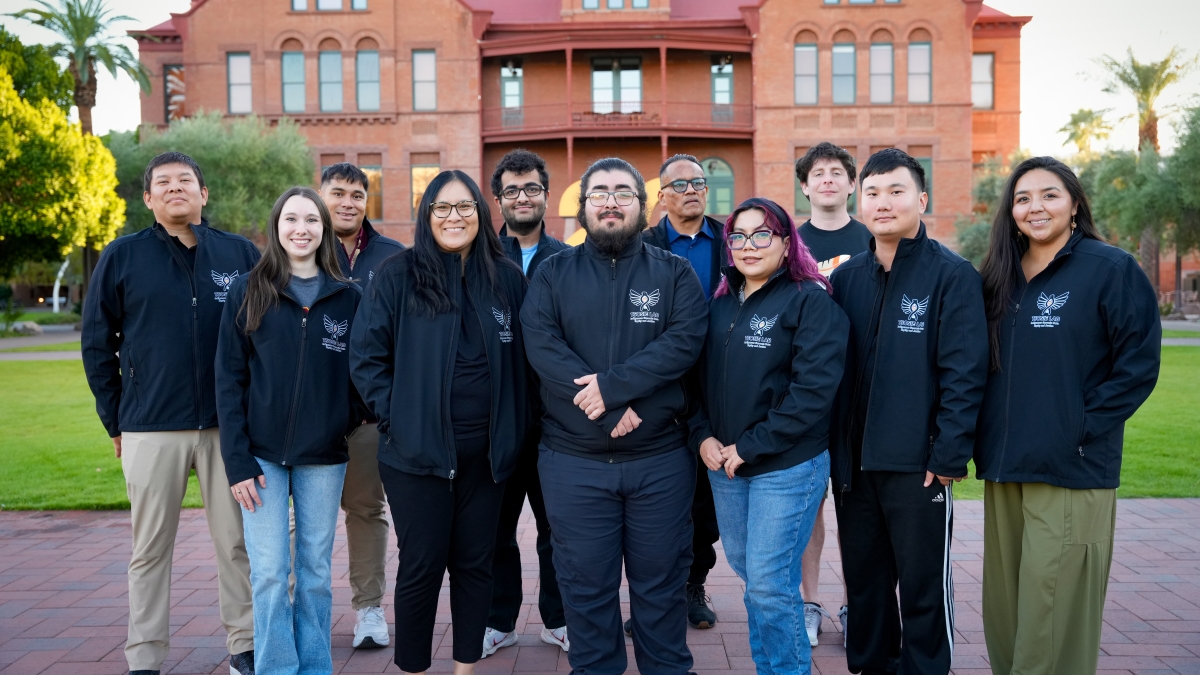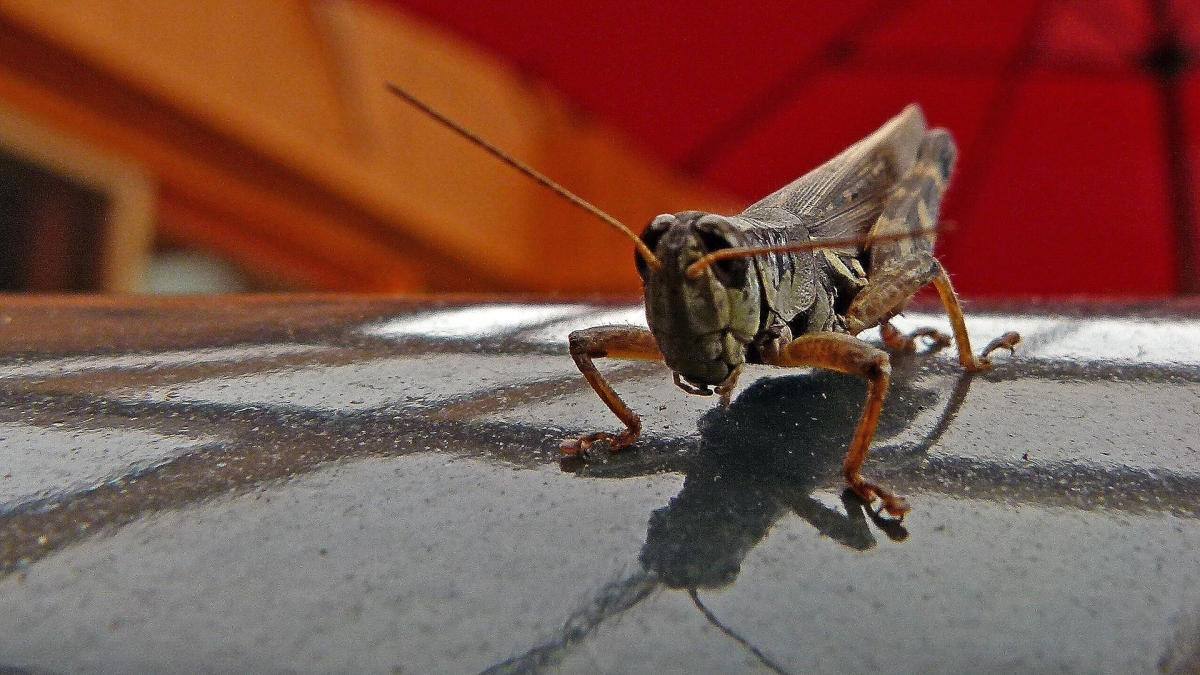First they devastated Somalia. Then Ethiopia. Now they’re ravaging most of East Africa, and there’s no sign of them stopping anytime soon.
Locusts of biblical proportions — estimated as high as 360 billion — are destroying crops and farmlands throughout Africa in places where food insecurity is already high, with the possibility of leaving millions starving.
Last month the insects devoured their way through Kenya from neighboring Somalia and Ethiopia. Africa hasn't seen an infestation like this since 1989. A United Nations official said it also has the potential to be the most devastating plague in living memory if something isn’t done soon.
Arizona State University’s Global Locust Initiative engages key actors in locust research and management to develop research, partnerships and solutions for transboundary pest management in agroecosystems around the world.
ASU Now consulted with Arianne Cease and Rick Overson, leaders of the initiativeThe Global Locust Initiative is housed in ASU's Julie Ann Wrigley Global Institute of Sustainability., to learn more about these insects, their eating habits and patterns, and what can be done to prevent outbreaks.
Arianne Cease
Question: As a child you saw grasshopper outbreaks and later, as a Peace Corps volunteer, locust swarms. What was that experience like?
Arianne Cease: I was first exposed to grasshopper outbreaks at around 5, growing up on my parents’ ranch in southern Oregon. I remember riding on the front bucket of the tractor through our grazing fields and seeing grasshoppers covering the ground and jumping everywhere. They competed with our livestock for the grass, but I was most interested in them as food for the pet praying mantises my brother and I would catch. Many years later after college, I arrived in the hot, sandy interior of Senegal as a sustainable agroforestry extension agent in 2005, on the tail end of the last major desert locust plague. Come the dry season, another grasshopper outbreak arrived and ate everything. I watched as villagers tried to protect trees and gardens with machetes or pesticides. It was futile. In the end, the locusts ate everything, even the bark off the trees.
Q: Locusts are mostly solitary. So why do they swarm in big numbers, and what causes them to swarm in the first place?
Rick Overson: Locusts have the ability to undergo a dramatic switch in their development in response to the environment called phase polyphenism. When environmental conditions are right, such as warm temperatures and the right amount of rain to grow the plants that they need for food, their numbers can increase dramatically. At some point, locusts can sense this crowding and switch to a gregarious phenotype, or form. This transition to the gregarious form causes changes in behavior, size, color, physiology and behavior depending on the species. For example, locusts move around more and become attracted to members of their own species. If the right environmental conditions persist, locusts aggregate and march together in locust bands, and after they become adults and grow functional wings, they will then begin to swarm together. Swarms of the desert locust can vary in size from 1 to more than 100 per square kilometer with densities of tens of millions of locusts per square kilometer.
Q: In Ethiopia and Somalia, they haven’t had outbreaks of this magnitude in decades. What’s driving them to that region?
Overson: Outbreaks of the desert locust go through phases of recession and plagues, both of which can play out over scales of years and decades and are difficult to predict. During recession years, desert locusts can be found in a 16-million-square-kilometer area covering 30 countries, but during plague years, the potential affected area can expand to an enormous 29-million-square-kilometer area spanning across 60 countries. The horn of Africa, which is the recipient of the current headlining swarms, historically saw outbreaks of even greater magnitude through the mid-1950s. A combination of lack of locust-promoting rains and extensive monitoring and control efforts by FAOThe Food and Agriculture Organization of the United Nations. and its commissions in frontline countries kept them at bay in this region for decades.
The current desert locust outbreak originated mainly along the Red Sea, which is a key winter breeding area for this species, due to favorable rains during the 2018-19 breeding season. A combination of continued locust-favorable rains in key areas and a decrease in monitoring resources and capacity led to the perfect storm. Thus, understanding and managing locusts requires a highly multifaceted approach including environmental, technological and human dimensions. For example, Yemen’s civil war is cited as having played a role in the current upsurge.
On the other side of the world, since the start of the South American locust upsurge in 2015, Bolivia, Paraguay and Argentina have all declared states of emergency, and large swarms continue to darken skies. This the first major upsurge in 60 years, so many locust programs had to be built from the ground up. Locusts are still quite unpredictable, and we have a lot to learn.
Q: Despite killing crops, what are types of damage can locusts do?
Cease: Luckily, there is no evidence that suggests locusts can carry diseases that could harm humans, so most of their impact is on plants. In addition to eating plants, sometimes the weight of locusts roosting on trees is so great that it breaks branches! However, beyond immediate effects on agriculture, locust outbreaks can have substantial long-term impacts on livelihoods. An economic study looking at the 1988 desert locust outbreaks in Mali found that children born during plague years in villages impacted by locusts were much less likely to start school than children born in villages not impacted by locusts.
Rick Overson
Q: Are there preventive measures or have there been any advancements in stopping them?
Overson: The swarms in East Africa are composed of the desert locust (Schistocerca gregaria). Outbreaks of this species originate in vast, largely uninhabited and highly remote areas of the desert. Managing this species could be thought of as analogous to managing forest fires. Careful monitoring followed with treating small, localized fires can prevent massive forest fires from emerging. Similarly, for the desert locust, locating and treating small outbreaks before they turn into gigantic swarms is the current best practice for minimizing pesticide use and avoiding an international food security crisis.
Several institutions are working to minimize the negative ecological and human health effects of pesticides in two major areas. First, minimizing the total amount of pesticide required to effectively control grasshoppers and locusts. This can be through catching outbreaks early, as mentioned before, more efficient spraying, more targeted application of pesticides from drones, and other techniques. Second, use of biopesticides, which are pathogens specific to grasshoppers isolated from nature and mass-produced for locust control. These have great potential as a much less ecologically disruptive pesticide, but there are additional challenges in developing and applying them effectively. In recent years, China has made great strides and investments in locust and grasshopper management through fine-tuning and production of biocontrol agents, in particular a fungus that only attacks grasshoppers.
For other locust species that originate in agricultural areas, we can look to additional tools such as specific agricultural practices that may keep populations low. For example, our research suggests that for species originating in grazing areas, increasing the protein content of plants by decreasing livestock grazing pressure may keep them at bay. We are implementing this management practice on the ground for Senegalese grasshoppers with partners in Senegal.
In any case, managing locusts requires a tremendous team effort of individuals working together across sectors and borders. To this aim, we are developing the Global Locust Initiative at Arizona State University that currently connects more than 30 organizations from six continents.
Q: Can you explain a bit more what the Global Locust Initiative does and how it contributes to outbreak response?
Cease: GLI is an Arizona State University initiative whose mission is to promote interdisciplinary locust research and management to improve the well-being of farming communities and global food system sustainability. GLI has two arms: GLI Network and GLI Labs. GLI Network's purpose is to connect universities, government and nongovernment organizations, and agricultural communities to forge new partnerships that seek to better integrate locust research and management. GLI Labs hosts a number of research projects spanning natural sciences — physiology, behavior, ecology, ecosystems — and social sciences — governance, economics — with the aim of advancing our fundamental understanding of the systems in which locusts and grasshoppers exist, as well as supporting development of local solutions to the global challenge of locust plagues.
Top photo: During a plague year, locusts can impact 1 in 10 people and cover 20% of Earth's land surfaces, according to ASU's Global Locust Initiative. Photo by Pixabay
More Science and technology

Cosmic clues: Metal-poor regions unveil potential method for galaxy growth
For decades, astronomers have analyzed data from space and ground telescopes to learn more about galaxies in the universe. Understanding how galaxies behave in metal-poor regions could play a crucial…

Indigenous geneticists build unprecedented research community at ASU
When Krystal Tsosie (Diné) was an undergraduate at Arizona State University, there were no Indigenous faculty she could look to in any science department. In 2022, after getting her PhD in genomics…

Pioneering professor of cultural evolution pens essays for leading academic journals
When Robert Boyd wrote his 1985 book “Culture and the Evolutionary Process,” cultural evolution was not considered a true scientific topic. But over the past half-century, human culture and cultural…


